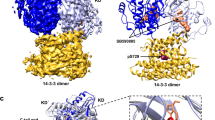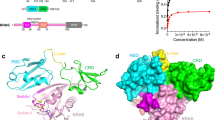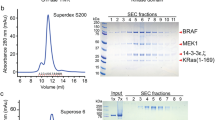Abstract
The plasma membrane-bound mammalian ras proteins of relative molecular mass 21,000 (ras p21) share biochemical and structural properties with other guanine nucleotide-binding regulatory proteins (G-proteins)1–3. Oncogenic ras p21 variants result from amino acid substitutions at specific positions that cause p21 to occur predominantly complexed to GTP in vivo. Recently, a GTPase activating protein (GAP) with cytosolic activity has been discovered that stimulates the GTPase activity of normal but not of oncogenic ras p21 (ref. 4). GAP might be either a negative regulatory agent which acts further upstream in the regulatory pathway or the downstream target of ras p21 (refs 3, 5 and 6). We have identified a protein from bovine brain with apparent relative molecular mass 125,000 that has GAP activity7. Here, using pure GAP in a kinetic competition assay, we show that GAP interacts preferentially with the active GTP complexes of both normal and oncogenic Harvey (Ha) ras p21 compared with the inactive GDP complexes. We also report the cloning and sequencing of the complementary DNA for bovine GAP. Regions of GAP share amino acid similarity with the noncatalytic domain of adenylate cyclase from the yeast Saccharomyces cerevisiae8–10 and with regions conserved between phospholipase C-148, the crk oncogene product and the nonreceptor tyrosine kinases26,27.
This is a preview of subscription content, access via your institution
Access options
Subscribe to this journal
Receive 51 print issues and online access
$199.00 per year
only $3.90 per issue
Buy this article
- Purchase on Springer Link
- Instant access to full article PDF
Prices may be subject to local taxes which are calculated during checkout
Similar content being viewed by others
References
Barbacid, M. A. Rev. Biochem. 56, 779–827 (1987).
De Vos, A. M. et al. Science 239, 888–893 (1988).
Sigal, I. S. Nature 332, 485–486 (1988).
Trahey, M. & McCormick, F. Science 238, 542–545 (1987).
Calles, C. J., Hancock, J. F., Marshall, C. J. & Hall, A. Nature 332, 548–551 (1988).
Adari, H., Lowy, D. R., Willumsen, B. M., Der, C. J. & McCormick, F. Science 240, 518–521 (1988).
Gibbs, J. B., Schaber, M. D., Allard, W. J., Sigal, I. S. & Scolnick, E. M. Proc. natn. Acad. Set. U.S.A. 85, 5026–5030 (1988).
Broek, D. et al. Cell 41, 763–769 (1985).
Field, J. et al. Molec. cell. Biol. 8, 2159–2165 (1988).
Marshall, M. S., Gibbs, J. B., Scolnick, E. M. & Sigal, I. S. Molec. cell. Biol. 8, 52–61 (1988).
Ricketts, M. H. & Levinson, A. D. Molec. cell. Biol. 8, 1460–1468 (1988).
Sigal, I. S., Gibbs, J. B., D'Alonzo, J. S. & Scolnick, E. M. Proc. natn. Acad. Sci. U.S.A. 83, 4725–4729 (1986).
Kozak, M. Nucleic Acids Res. 12, 857–872 (1984).
Feramisco, J. L., Glass, D. B. & Krebs, E. G. J. bio. Chem. 255, 4240–4245 (1980).
Pike, L. J., Gallis, B., Canellie, J. E., Bornstein, P. & Krebs, E. G. Proc. natn. Acad. Sci. U.S.A. 79, 1443–1447 (1982).
Wilbur, W. J. & Lipman, D. J. Proc. natn. Acad. Sci. U.S.A. 80, 726–730 (1983).
Kataoka, T., Broek, D. & Wigler, M. Cell 43, 493–505 (1986).
Dixon, R. A. F. et al. Nature 321, 75–79 (1986).
Pearl, L. H. & Taylor, W. R. Nature 329, 351–354 (1987).
DeFeo-Jones, D. et al. Science 228, 179–184 (1985).
Uno, I., Mitsuzawa, H., Tanaka, K., Oshima, T. & Ishikawa, T. Molec. Gen. Genet. 210, 187–194 (1987).
Tucker, J. et al. EMBO J. 5, 1351–1358 (1986).
Gibbs, J. B., Sigal, I. S., Poe, M. & Scolnick, E. M. Proc. natn. Acad. Sci. U.S.A 81, 5704–5708 (1984).
Smith, T. F. & Waterman, M. S. Adv. appl. Math. 2, 482–489 (1981).
Schwartz, R. M. & Dayhoff, M. O. in Atlas of Protein Sequence and Structure (ed. Dayhoff, M. O.) 353–358 (National Biomedical Research Foundation, Washington D.C., 1979).
Stahl, M. L., Ferenz, C. R., Kelleher, K. L., Kriz, R. W. & Knopf, J. L. Nature 332, 269–272 (1988).
Mayer, B. J., Hamaguchi, M. & Hanafusa, H. Nature 332, 272–275 (1988).
Author information
Authors and Affiliations
Rights and permissions
About this article
Cite this article
Vogel, U., Dixon, R., Schaber, M. et al. Cloning of bovine GAP and its interaction with oncogenic ras p21. Nature 335, 90–93 (1988). https://doi.org/10.1038/335090a0
Received:
Accepted:
Published:
Issue Date:
DOI: https://doi.org/10.1038/335090a0
Comments
By submitting a comment you agree to abide by our Terms and Community Guidelines. If you find something abusive or that does not comply with our terms or guidelines please flag it as inappropriate.



